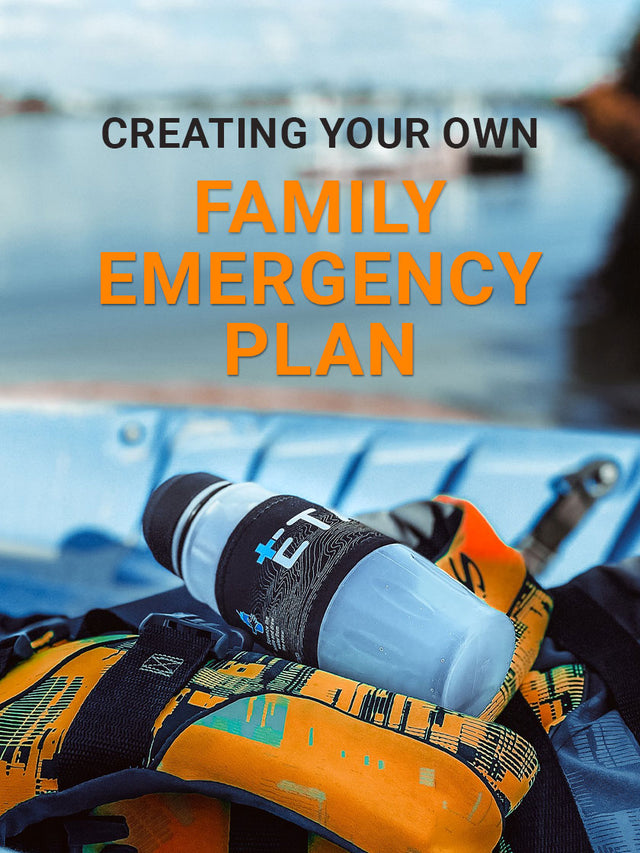
Creating your own Family Emergency Plan
According to cdc.gov, only 39% of Americans have developed and discussed an emergency plan with their family. Having a plan and being ready in case of an emergency is a crucial aspect of family safety. An essential factor of disaster preparedness is understanding the different types of disasters and how they affect both children and adults, how to create a plan, practicing the implementation of the plan in real and orderly ways, and making sure you have the materials to support your family in an emergency. Damage can be slight or extreme. Their effects may be limited or broad, predictable or unexpected. As a family, you should be prepared for any kind of emergency.

Depending on how serious the incident was, it could have long-term effects on any location's infrastructure and utilities. Some of these top emergencies are most likely to occur, while others are less likely to happen yet more devastating and thus, require special attention.
What is a family emergency plan?
A family disaster plan is a specific action plan that guides and instructs each household member how to prepare beforehand and what to do in specific emergency situations. If you are prepared as a family or are in the process of building an emergency plan that works for you, you’re taking the appropriate measures for the safety and security of your family. If you aren’t thinking about it yet, now is the right time to start making progress.
Preparedness can reduce the loss of lives and properties. Emergency planning must be an ongoing, dynamic activity. Regular assessments and revisions take into account dangers, conditions, and tenants that change. Recovery initiatives are extremely important. It will be necessary to act swiftly to communicate limits, allow personnel to enter into facilities safely, and hire qualified contractors to undertake repairs. Take all of these into account while creating your preparedness strategy.
What are the 4 main parts of emergency management?
Disasters are viewed as recurring events by emergency managers that
consist of four stages main stages as Mitigation, Readiness, Response, and
Recovery.
- Mitigation: This step includes stages taken to mitigate or prevent disasters' causes, effects, and consequences.
- Preparedness: Planning, training, and educational initiatives are part of this phase for unavoidable events.
- Response: In the immediate event of a crisis, the reaction phase takes place. Business and other operations do not run regularly during the response period. The level of preparedness affects both the time of the response phase and individual safety and wellbeing in an emergency.
- Recovery: Restoration initiatives take place alongside routine operations and activities during the recovery phase. A disaster's recovery process may take a while.

Things to consider in the emergency plan
You may think that a family emergency plan is an easy task, all you have to do is pack some stuff and leave for a safe place. But it is not as easy as it sounds unless planned well. You have to be prepared and you have to be well organized so that an emergency plan is successful. So, we have collated the most important parts that you need to pay attention to during the preparation of an emergency plan.
01. Planning - Consider a variety of emergency situations. When creating disaster preparedness plans, the unforeseen, the unheard of, and the ‘it could never happen here or to me’ scenarios should all be taken into account.
02. Training - This is crucial for making personnel in charge of carrying out the plan competent, self-assured, and ready. This includes both classroom and real-world training.
03. Drills - Physical drills involving all service providers, including security, cleaning, engineering, fire wardens, and tenant representatives, will bring those plans to life. These drills can be facilitated by your security team.
04. Knowledge - The integrators who install emergency systems must actively take part in training security and management on how to use those systems correctly and effectively.
05. Technological - Make use of technology to assist with reliable emergency plan communication. These kinds of tools can be modified to fit the particular quirks of your property. Create a training CD or online module, for instance, that include floor plans, evacuation routes, and information about things like fire extinguisher placements.
06. Coordination - Some tenants in multi-tenant buildings could have individual emergency plans. Those tenants should be commended for their efforts, but coordination of planning is required to avoid disagreements and clear up uncertainty in the event of an emergency.
07. Communication - Local authorities and everyone inside your building should be informed of your emergency plans. It will be easier to execute plans in an emergency case if they are shared in advance. Most likely, your security staff has a connection to the neighborhood emergency services and can act as a liaison.

Why is it important to prepare a family emergency preparedness plan?
Families might not be together when a disaster happens. So, it's crucial to make plans in advance for how they will communicate, reunite, and respond to various situations. A working family disaster plan reduces anxiety around potential disasters, lessens the stress of actual crisis circumstances, and buys valuable time in the event of a disaster.
If you don’t have an accurate family emergency plan, it’s a messed up mesh. Just imagine if you don't have anything ready, no backup supply of utilities, nowhere to go, and no way to contact anyone; how would you act and protect your family? But if you are fully prepared with a well-organized plan to act regardless of the emergency situation, time or location, that is when you are successful and that is when your family is safe.
ETA’s support
In case of an emergency, one of the major requirements is supplying necessary food and water. If you are prepared, you can store canned food initially. And you might think, storing bottled water is the next solution for emergency water supply.
But this is the time to think beyond just the need of water. You need to think about you, your family and the environment as well. With these single-use plastics like bottled water, you are polluting nature and also, you have to think of the price whether it’s affordable or not. Also, with that, you have access to only limited availability.

You should seek for a system that combines filtration and purification, emergency readiness, reusability and affordability to ensure that you have access to clean water in any case of an emergency situation.
The revolutionary "ETA Alkaline Water Filter Bottle" uses the groundbreaking
IAMF technology. The device's unique "Sip & Squeeze" mechanism activates its EXTREME FILTRATION process, which removes ALL 4 types of water pollution zones, including radiological components, and ultimately makes it the greatest water filter bottle in the world. Additionally, rapid alkalized water with a pH of 9.5 and a 30-day shelf life is produced by the unique IAMF technology.
You may save money, protect the environment by avoiding the use of plastic water bottles, and stay healthy and hydrated by carrying a filtered water bottle or using a water bottle filter while in an emergency or when preparing your family emergency plan.
Count on the ETA Alkaline Water Filter Bottle to be your partner in the rescue mission during any emergency!
